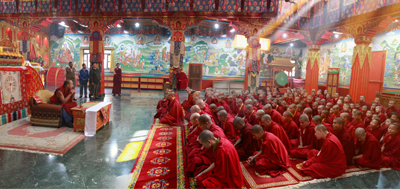December 30, 2011- Sarnath, Varanasi.
 His Holiness the Karmapa today addressed a group of 80 butter sculptors, including monks and nuns from over 35 monasteries and nunneries. Tibetan butter sculptures, sometimes loosely referred to tormas, are ritual cakes typically made of butter and other substances and often beautifully decorated. Each year, His Holiness appoints teams to create a dazzling visual feast of such images of buddhas, bodhisattvas and other holy beings. These butter sculptures are displayed as an offering on the altar set up before the Bodhi tree in Bodhgaya, Buddhism´s most sacred place, during the annual Kagyu Monlam prayer gathering. The making of butter sculpture is practiced widely across all sects of Tibetan Buddhism, with detailed guidelines regulating what sort of butter sculpture should be offered on various ritual occasions.
His Holiness the Karmapa today addressed a group of 80 butter sculptors, including monks and nuns from over 35 monasteries and nunneries. Tibetan butter sculptures, sometimes loosely referred to tormas, are ritual cakes typically made of butter and other substances and often beautifully decorated. Each year, His Holiness appoints teams to create a dazzling visual feast of such images of buddhas, bodhisattvas and other holy beings. These butter sculptures are displayed as an offering on the altar set up before the Bodhi tree in Bodhgaya, Buddhism´s most sacred place, during the annual Kagyu Monlam prayer gathering. The making of butter sculpture is practiced widely across all sects of Tibetan Buddhism, with detailed guidelines regulating what sort of butter sculpture should be offered on various ritual occasions.
In order to preserve this unique form of Tibetan Buddhist spiritual art, His Holiness had requested two senior masters from Bhutan to spend an intensive period transmitting their knowledge and skills to a younger generation of butter sculptors. Among those apprenticing under Lama Sonam Rinchen and Gen Tsering Paljor, the two master butter scupltors, are Tsurphu Labrang’s own ritual master, Osel Nyingpo, and thangka painter, Karma Wangchuk. In the talk the Gyalwang Karmapa gave at Vajra Vidya Insitute in Varanasi, he offered the group encouragement and guidance on how to approach their art as a spiritual practice.
His Holiness commented that because of the great gathering of heart sons, lamas and monastics, who serve as a special field of merit, Kagyu Monlam offers particularly powerful conditions for accumulating merit or good karma. Given such an ideal opportunity, it was appropriate to make extra efforts to create vast and high-quality offerings, without taking any shortcuts. Yet he cautioned against allowing any feelings or pride or competitiveness, comparing their butter sculptures with those of other lineages.
His Holiness noted that long-life pujas would be offered this year to the heart sons His Eminences Tai Situ Rinpoche and Gyaltsab Rinpoche, and that he himself was also planning to pass the pre-losar period in Bodhgaya, performing the accompanying gutor rituals in an expanded manner. As such, an especially large number of people were likely to view this year’s butter sculptures before and during Kagyu Monlam. For this reason, the team should undertake their task with a wish to cause joy to all those who saw the sculptures, and to inspire them to greater virtue. In this way, the act of making butter sculptures could become especially beneficial for them and for others.
Since each color and artistic element of the different kinds of butter sculptures had deep symbolic meanings, it was important for them to learn and hold those meanings in mind, His Holiness said. As he spoke, the Gyalwang Karmapa consistently spoke of their work in the same terms as used for images of deities in painting and metal sculptures, emphasizing that the butter sculptors are, in fact, creating sacred images.
Furthermore, the Gyalwang Karmapa pointed out that butter sculpting had begun to attract international attention as a unique Tibetan art form, and this should encourage them all to value and enhance their own knowledge and skills in this art. (Under the Gyalwang Karmapa’s direction, a documentary film about butter sculptures is currently under way. Find out more about this project at: www.tormafilm.com)


